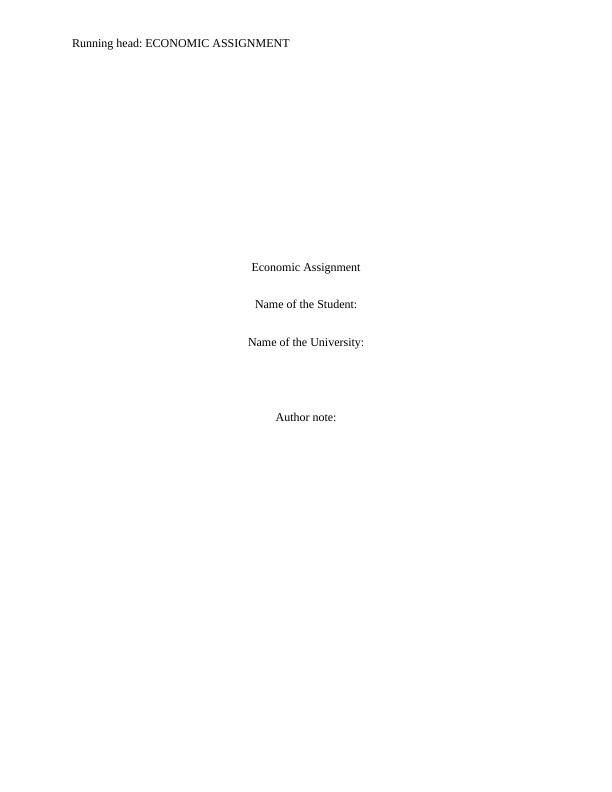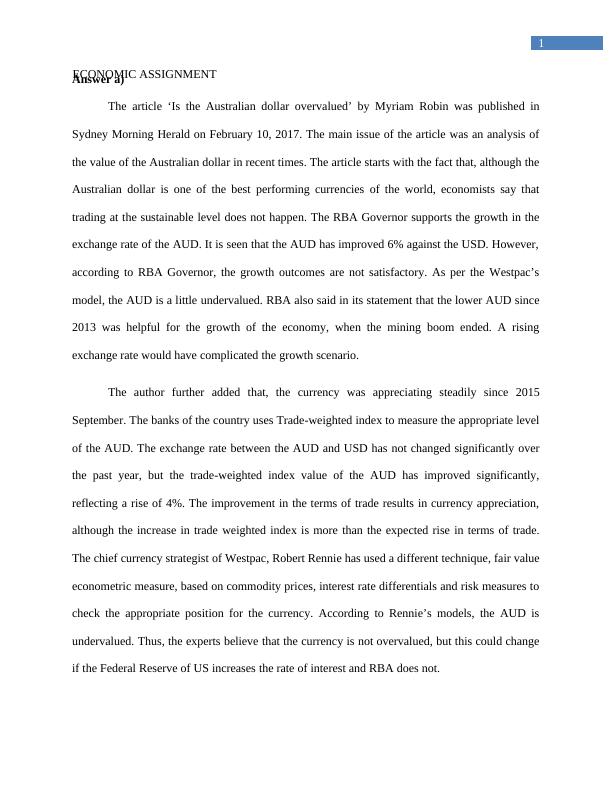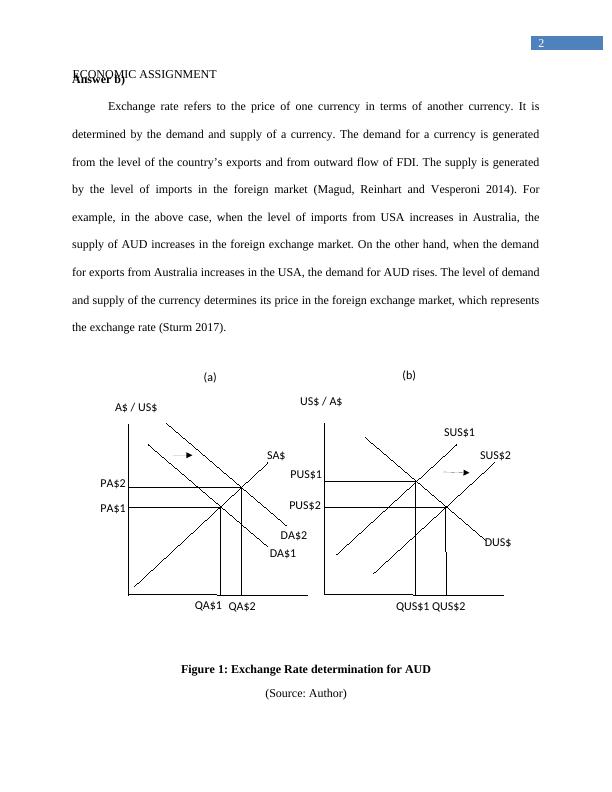Economics Assignment Article Australian Dollar
15 Pages2918 Words84 Views
Added on 2020-04-07
Economics Assignment Article Australian Dollar
Added on 2020-04-07
ShareRelated Documents
Running head: ECONOMIC ASSIGNMENTEconomic AssignmentName of the Student:Name of the University:Author note:

1ECONOMIC ASSIGNMENTAnswer a)The article ‘Is the Australian dollar overvalued’ by Myriam Robin was published inSydney Morning Herald on February 10, 2017. The main issue of the article was an analysis ofthe value of the Australian dollar in recent times. The article starts with the fact that, although theAustralian dollar is one of the best performing currencies of the world, economists say thattrading at the sustainable level does not happen. The RBA Governor supports the growth in theexchange rate of the AUD. It is seen that the AUD has improved 6% against the USD. However,according to RBA Governor, the growth outcomes are not satisfactory. As per the Westpac’smodel, the AUD is a little undervalued. RBA also said in its statement that the lower AUD since2013 was helpful for the growth of the economy, when the mining boom ended. A risingexchange rate would have complicated the growth scenario. The author further added that, the currency was appreciating steadily since 2015September. The banks of the country uses Trade-weighted index to measure the appropriate levelof the AUD. The exchange rate between the AUD and USD has not changed significantly overthe past year, but the trade-weighted index value of the AUD has improved significantly,reflecting a rise of 4%. The improvement in the terms of trade results in currency appreciation,although the increase in trade weighted index is more than the expected rise in terms of trade.The chief currency strategist of Westpac, Robert Rennie has used a different technique, fair valueeconometric measure, based on commodity prices, interest rate differentials and risk measures tocheck the appropriate position for the currency. According to Rennie’s models, the AUD isundervalued. Thus, the experts believe that the currency is not overvalued, but this could changeif the Federal Reserve of US increases the rate of interest and RBA does not.

2ECONOMIC ASSIGNMENTSA$SUS$1SUS$2DUS$DA$1DA$2PA$1PA$2PUS$1A$ / US$QUS$1QUS$2QA$1QA$2PUS$2US$ / A$(a)(b)Answer b)Exchange rate refers to the price of one currency in terms of another currency. It isdetermined by the demand and supply of a currency. The demand for a currency is generatedfrom the level of the country’s exports and from outward flow of FDI. The supply is generatedby the level of imports in the foreign market (Magud, Reinhart and Vesperoni 2014). Forexample, in the above case, when the level of imports from USA increases in Australia, thesupply of AUD increases in the foreign exchange market. On the other hand, when the demandfor exports from Australia increases in the USA, the demand for AUD rises. The level of demandand supply of the currency determines its price in the foreign exchange market, which representsthe exchange rate (Sturm 2017). Figure 1: Exchange Rate determination for AUD(Source: Author)

3ECONOMIC ASSIGNMENTFrom the above figure, the exchange rate determination is shown. In figure 1(a), thedemand side fluctuations are shown and in figure 1(b), supply side fluctuations are shown forAUD in terms of USD. When the demand for AUD rises against USD, the demand curve for theAUD shifts to the right, from DA$1 to DA$2, supply remaining the same. Thus, the price for AUDrises to PA$2 from PA$1. AUD appreciates in this case. At the same time, supply of USD falls dueto fall in demand for the US exports in the Australian market. Hence, the price of USD fallsagainst AUD. The exchange rate for AUD against USD is the equilibrium where the demand andsupply for AUD becomes equal in terms of USD. The following factors determine the exchange rate fluctuations in Australia:Prices of commodity and terms of trade: The terms of trade of a country is influenced bythe commodity prices, as it is dependent on the commodity exports. Hence, fluctuations in thecommodity prices lead to fluctuations in the exchange rate (Ghosh, Ostry and Chamon 2016). Relative inflation rates: If the inflation rate rises in USA, the commodities become moreexpensive, hence, its demand falls. The level of trade changes leading to exchange ratefluctuations. Relative national income growth rates: The country with a higher income growthdemands more imported goods, thereby increasing the supply of home currency in theinternational market. Hence, exchange rate improves in favor of this country. Relative interest rate: The country with a relatively higher interest rate draws moremoney in terms of investments. The citizens keep the money within the country and thus, theflow of money and exchange rate change (Levy-Yeyati and Sturzenegger 2016).

End of preview
Want to access all the pages? Upload your documents or become a member.
Related Documents
The Australian Dollar (AUD)lg...
|8
|2190
|33
Demand and Supply Model to AUD/USD Exchange Rate : Reportlg...
|9
|2205
|50
Economics Assignment - “Is the Australian Dollar Overvalued”lg...
|14
|2882
|29
(PDF) Home Economics as professional practicelg...
|14
|3072
|50
Impact of Low Interest Rates on Australian Dollar and International Tradelg...
|6
|1361
|275
Economics Assignment - Overvalued Australian Dollarlg...
|14
|2782
|66
